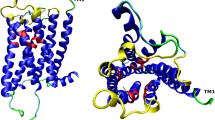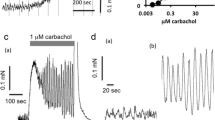Summary
The effects of low concentrations (< = 1 μmM) of the anti-diarrhoeal drug lidamidine and sub-anaesthetic concentrations (< = 1 μM) of tetracaine on the binding of the muscarinic antagonist [3H] N-methylscopolamine ([3H]NMS) and the high affinity muscarinic agonist, [3H] oxotremorine-M ([3H]oxo-M) to broken cell preparations of rabbit ileal submucosal membranes were investigated. High affinity [3H]NMS binding (K D = 0.79 ± 0.05 nM, B max = 1.75 ± 0.13 pmoles · mg−1) was unaffected by either lidamidine or tetracaine. Inhibition of NMS binding by the muscarinic agonist carbachol was reduced by the nonhydrolyzable analogue of GTP, GppNHp. This effect of GppNHp was partially prevented by lidamidine. Analysis of equilibrium binding of the muscarinic agonist [3H] oxotremorine-M revealed that the binding of oxotremorine-M could be best described by the presence of the least two populations of sites with affinities of 0.9 ± 0.2 and 27.7 ± 0.9 nM respectively. High affinity [3H] oxotremorine-M binding was markedly reduced by GppNHp, GDPβS and fluoride (5 mM). Neither lidamidine, nor tetracaine had any effect on the binding of oxotremorine-M when added alone. However, lidamidine and tetracaine prevented GppNHp, GDPβS and fluoride-induced reductions in oxotremorine-M binding. The present findings are consistent with an allosteric interaction between lidamidine or tetracaine and GppNHp-induced reductions in oxotremorine-M binding to submucosal muscarinic receptors. These effects are discussed in relation to the observed action of lidamidine in potentiating presynaptic inhibition of acetylcholine release by muscarinic agonists.
Similar content being viewed by others
References
Aguilar JS, Criado M, De Robertis E (1980) Inhibition by local anaesthetics, phentolamine and propranolol of 3H quinuclydinyl benzylate binding to central muscarinic receptors. Eur J Pharmacol 68:317–326
Ahsan MA, Bleakman D, Naftalin RJ (1986) Lidamidine, a specific antagonist to substance P-induced secretion in rabbit ileum. J Physiol 378:32P
Barritt D, Yamamura HI, Roeske WR (1982) Muscarinic receptor binding in the mouse heart: The selective modulatory effect of fluoride ion on agonist binding. Life Sci 30:875–877
Benyon RJ (1985) A general purpose non-linear curve fitting program for the British Broadcasting Corporation Microcomputor. Cabios Commun 1(2):111–115
Berry CP, Birdsall NJM, Burgen ASV, Hulme EC (1979) Guanine nucleotides modulate muscarinic receptor binding in the heart. Biochem Biophys Res Commun 87:1000
Birdsall NJM, Burgen ASV, Hulme EC (1978) The binding of agonists to brain muscarinic receptors. Mol Pharmacol 14: 723–736
Bleakman D, Naftalin RJ (1985) Modulation of acetylcholine release from the isolated rabbit small intestinal submucosa by fluoride and lidamidine. J Physiol 371:226P
Briggs CA, Cooper JR (1982) Cholinergic modulation of the release of 3H acetylcholine from synaptosomes of the myenteric plexus. J Neurochem 38:501–508
Bury RW, Mashford ML (1976) Interactions between local anaesthetics and spasmogens on the guinea-pig ileum. J Pharmacol Exp Ther 197:633–640
Dhar AK, Eash JR, Mir GN (1983) Alpha-adrenoceptor activity of lidamidine. Fed Proc 42:1367
Durbin T, Rosenthal L, McArthur K, Anderson D, Dhamsathaphorn K (1982) Clonidine and lidamidine (WHR-1142) stimulate sodium and chloride absorption in the rabbit intestine. Gastroenterology 82:1352–1358
Ehlert FJ, Roeske WR, Yamamura HI (1981) Muscarinic receptor: Regulation by guanine nucleotides, ions, and N-ethylmaleimide. Fed Proc 40:153–159
Feinstein MB, Paimre M (1967) Mode of anticholinergic action of local anaesthetics. Nature 214:151–153
Fields JZ, Roeske WR, Morkin E, Yamamura HI (1978) Cardiac muscarinic cholinergic receptors. Biochemical identification and characterization. J Biol Chem 253:3251–3258
Fosbraey P, Johnson ES (1980) Modulation by acetylcholine of the electrically evoked release of 3H acetylcholine from the ileum of the guinea-pig. Br J Pharmacol 69:145–149
Gilman AG (1984) G proteins and dual control of adenylate cyclase. Cell 36:577–579
Gullikson GW, Dajani EZ, Bianchi RG (1981) Inhibition of intestinal secretion in the dog. A new approach for the management of diarrhoeal states. J Pharmacol Exp Ther 219: 591–597
Hammer R, Berrie CP, Birdsall NJM, Burgen ASV, Hulme EC (1980) Pirenzepine distinguishes between different subclasses of muscarinic receptors. Nature 283:90–92
Hulme EC, Berrie CP, Birdsall NJM, Jameson M, Stockton JM (1983) Regulation of muscarinic agonist binding by cations and guanine nucleotides. Eur J Pharmacol 94:59–72
Kilbinger H (1984) Facilitation and inhibition by muscarinic agonists of acetylcholine release from guinea-pig myenteric neurones: mediation through different types of muscarinic receptors. Trends Pharm Sci (Supplement) 49–52
Kilbinger H, Wessler I (1980) Pre- and postsynaptic effects of muscarinic agonists in the guinea-pig ileum. Naunyn-Schmiedeberg's Arch Pharmacol 314:259–266
Löffelholz K, Muscholl E (1969) A muscarinic inhibition of the noradrenaline release evoked by postganglionic sympathetic nerve stimulation. Naunyn-Schmiedeberg's Arch Pharmacol 265:1–15
Lowry OH, Rosebrough NJ, Farr AL, Randall RJ (1951) Protein measurement with the Folin phenol reagent. J Biol Chem 193:265–275
Mattera R, Pitts BJR, Entman ML, Birmbaumer L (1985) Guanine nucleotide regulation of a mammalian myocardial muscarinic receptor system. J Biol Chem 260:7410–7421
McMahon KK, Hosey MM (1983) Potentiation of monovalent cation effects on ligand binding to cardiac muscarinic receptors in N-ethylmaleimide treated membranes. Biochem Biophys Res Commun 11:41–46
Mir GN, Sperow JW, Krebs JB, Eash JR, Rowles GS, Yelnosky J (1978) Mechanism of action studies of lidamidine hydrochloride (WHR-1142A), a novel anti-diarrhoeal agent. Arzneimittelforschung 28:1451–1461
Morita K, North RA, Tokimasa T (1982) Muscarinic presynaptic inhibition of synaptic transmission im myenteric plexus of the guinea-pig ileum. J Physiol 333:141–149
Nilvebrant L, Sparf B (1983) Differences between binding affinities of some antimuscarinic drugs in the parotid gland and those in the urinary bladder and ileum. Acta Pharmacol Toxicol 53: 304–313
Paton WDW (1955) The response of the guinea-pig ileum to electrical stimulation by coaxial electrodes. J Physiol 127:40–41 P
Richardson A, Humrich A (1984) A microcomputor program for the analysis of radioligand binding curves and other dose-response data. Trends Pharm Sci 5:47–49
Richelson E, Prendergast FG, Divinetz-Romero S (1978) Muscarinic receptor-mediated cyclic GMP formation by cultured nerve cells-ionic dependence and effects of local anaesthetics. Biochem Pharmacol 27:2039–2048
Rodbell M (1980) The role of hormone receptors and GTP-regulatcry proteins in membrane transduction. Nature 284:17–21
Roeske WR, Ehlert FJ, Barritt DS, Yamanaka K, Rosenberger LB, Yamada S, Yamamura S, Yamamura HI (1982) In: Segawa T, Yamamura HI, Kuriyama K (eds) Recent advances in muscarinic receptor heterogeneity and regulation, molecular pharmacology of neurotransmitter systems. Raven Press, New York, pp 15–30
Scatchard G (1949) The attraction of proteins for small molecules and ions. Ann NY Acad Sci 51:660–672
Strnad NP, Cohen JB (1983) Tetracaine binding to Torpedo postsynaptic membrane. Soc Neurosci Abstr 9:106A
Wilkinson GN (1961) Statistical evaluation in enzyme kinetics. Biochem J 80:324–336
Yamamura HI, Snyder S (1974) Muscarinic cholinergic receptor binding in longitudinal muscle of the guinea-pig ileum with 3H quinuclidynyl benzilate. Mol Pharmacol 10: 861–869
Author information
Authors and Affiliations
Additional information
Send offprint requests to D. Bleakman
Rights and permissions
About this article
Cite this article
Bleakman, D., Naftalin, R.J. Prevention of guanine nucleotide-induced reductions in muscarinic agonist binding to rabbit ileal submucosal membranes by lidamidine and tetracaine. Naunyn-Schmiedeberg's Arch Pharmacol 337, 366–372 (1988). https://doi.org/10.1007/BF00169525
Received:
Accepted:
Issue Date:
DOI: https://doi.org/10.1007/BF00169525




